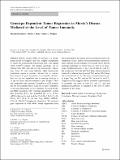| dc.description.abstract | Marek’s disease (MD) of chickens is a unique
natural model of Hodgkin’s and Non Hodgkin’s lymphomas
in which the neoplastically-transformed cells over-express
CD30 (CD30hi) antigen. All chicken genotypes can be
infected with MD virus and develop microscopic lymphomas.
From 21 days post infection (dpi) microscopic
lymphomas regress in resistant chickens but, in contrast,
they progress to gross lymphomas in susceptible chickens.
Here we test our hypothesis that in resistant chickens at
21 dpi the tissue microenvironment is pro T-helper (Th)-1
and compatible with cytotoxic T lymphocyte (CTL) immunity
but in susceptible lines it is pro Th-2 or pro T-regulatory
(T-reg) and antagonistic to CTL immunity. We used the B2,
non-MHC-associated, MD resistance/susceptibility system
(line [L]61/line [L]72) and quantified the levels of key
mRNAs that can be used to define Th-1 (IL-2, IL-12, IL-18,
IFNγ), Th-2 (IL-4, IL-10) and T-reg (TGFβ, GPR-83,
CTLA-4, SMAD-7) lymphocyte phenotypes. We measured
gene expression in both whole tissues (represents tissue microenvironment and tumor microenvironment) and in the
lymphoma lesions (tumor microenvironment) themselves.
Gene ontology-based modeling of our results shows that the
dominant phenotype in whole tissue as well as in microscopic
lymphoma lesions, is pro T-reg in both L61 and L72
but a minor pro Th-1 and anti Th-2 tissue microenvironment
exists in L61 whereas there is an anti Th-1 and pro Th-2 tissue
microenvironment in L72. The tumor microenvironment per
se is pro T-reg, anti Th-1 and pro Th-2 in both L61 and L72.
Together our data suggests that the neoplastic transformation
is essentially the same in both L61 and L72 and that
resistance/susceptibility is | en_US |

